| Listing 1 - 10 of 12 | << page >> |
Sort by
|
Book
ISBN: 0323916481 0323913911 9780323913911 9780323916486 0128202939 9780323913928 032391392X 9780128202937 Year: 2022 Publisher: London, England ; San Diego, California : Elsevier,
Abstract | Keywords | Export | Availability | Bookmark
 Loading...
Loading...Choose an application
- Reference Manager
- EndNote
- RefWorks (Direct export to RefWorks)
Textbook of Arterial Stiffness and Pulsatile Hemodynamics in Health and Disease, Two Volume Set covers the principles, physiology, biologic pathways, clinical implications and therapeutics surrounding arterial stiffness and pulsatile hemodynamics, along with a thorough overview of the field. The book presents complex engineering concepts in a way that those in science and medicine can more easily understand. It includes detailed illustrations. Additionally, it presents advanced bioengineering concepts in boxes for readers who wants more in-depth biophysical knowledge. This is a must-have reference for students, researchers and clinicians interested in learning more about this field.
Arteries --- Hemodynamics. --- Hemodynamics --- Diseases. --- Hemodynamic --- Neurovascular Coupling --- Blood Circulation --- Blood --- Cardiac output --- Hydrodynamics --- Circulation --- Elastic properties. --- Arterial elasticity --- Biomechanics --- Elasticity --- Vascular Stiffness --- Pulsatile Flow --- Models, Theoretical --- Vascular Stiffness. --- Pulsatile Flow. --- Models, Theoretical.
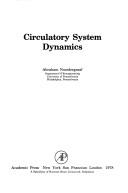
ISBN: 0125209509 0323141412 1299442986 Year: 1978 Publisher: New York (N.Y.) : Academic press,
Abstract | Keywords | Export | Availability | Bookmark
 Loading...
Loading...Choose an application
- Reference Manager
- EndNote
- RefWorks (Direct export to RefWorks)
Animal physiology. Animal biophysics --- Blood physiology. Circulatory physiology --- Blood Circulation. --- Hemodynamics. --- Blood --- -Hemodynamics --- Cardiac output --- Hydrodynamics --- Body fluids --- Fear of blood --- Hemodynamic --- Neurovascular Coupling --- Blood Circulation --- Circulation, Blood --- Cardiovascular System --- Pulsatile Flow --- Circulation --- Circulation. --- Hemodynamics --- Circulation of the blood --- Cardiovascular system --- Physiology --- Blood Flow --- Blood Flows --- Flow, Blood
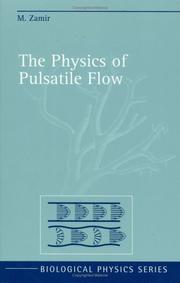
ISBN: 0387989250 1461270774 1461212820 Year: 2000 Publisher: New York : AIP Press : Springer,
Abstract | Keywords | Export | Availability | Bookmark
 Loading...
Loading...Choose an application
- Reference Manager
- EndNote
- RefWorks (Direct export to RefWorks)
Classic texts in the field of analysis of flow in blood vessels have been written over the years and what these say is still valid today. However, our knowledge of pathophysiological mechanisms has changed with increasing rapidity over the past 20 years, as has our ability to visualize the three dimensional geometry of blood flow and blood flow velocity distribution within the in vivo blood vessels. Consequently, with the increased need to fully exploit the new imaging capabilities and our additional biological knowledge, this book is a welcome addition to our armamentarium used to achieve those new goals. the past pulsatile flow (and consequent wave reflections) was Whereas in often seen as "frosting on the cake" of analysis of blood flow problems or perhaps as an issue that should be understood only in a general sense, our new capabilities and understanding require more accurate analyses of spe cific systems, not just of constructs based on statistical data describing a vascular tree. Examples of this new need include the situation where the detailed branching geometry of an arterial tree is known from imaging and it is desired to see to what extent local fluid dynamic characteristics can explain the specific localization of disease such as atherosclerosis, or of the extent to which the heterogeneity of perfusion throughout an organ can be attributed to the vascular tree branching geometry or to the mechani cal properties of the vascular walls.
Pulsatile Flow. --- Physics. --- Blood flow. --- Tubes --- Body fluids. --- Sang --- Liquides organiques --- Fluid dynamics. --- Débit --- Fluide, Dynamique des --- Débit --- Human physiology. --- Biophysics. --- Biological physics. --- Animal physiology. --- Human Physiology. --- Biological and Medical Physics, Biophysics. --- Animal Physiology. --- Animal physiology --- Animals --- Biology --- Anatomy --- Human biology --- Medical sciences --- Physiology --- Human body --- Biological physics --- Physics
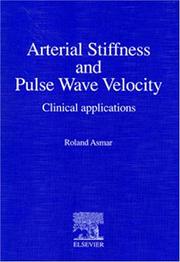
ISBN: 9782842991487 2842991486 Year: 1999 Publisher: Amsterdam ; New York : Elsevier,
Abstract | Keywords | Export | Availability | Bookmark
 Loading...
Loading...Choose an application
- Reference Manager
- EndNote
- RefWorks (Direct export to RefWorks)
Blood Flow Velocity --- Arteries --- Blood Pressure --- Cardiovascular System --- Pulsatile Flow --- Blood flow --- Blood --- Sang --- Artères --- physiology. --- physiopathology. --- drug effects. --- Circulation --- Débit --- Blood Pressure Determination. --- Cardiovascular Diseases --- Hypertension --- Blood Pressure Determinations --- Determination, Blood Pressure --- Artères --- Débit --- Blood Pressure Determination --- physiopathology --- physiology
Book
ISBN: 0815113641 0815113633 Year: 1975 Publisher: Chicago, IL : Year Book Medical Publishers,
Abstract | Keywords | Export | Availability | Bookmark
 Loading...
Loading...Choose an application
- Reference Manager
- EndNote
- RefWorks (Direct export to RefWorks)
Blood Circulation. --- -Hemodynamics --- Circulation, Blood --- Pulsatile Flow --- Blood. Cardiovascular, circulatory system --- 612.1 Blood. Cardiovascular, circulatory system --- 612.1 --- Blood --- Body fluids --- Fear of blood --- Cardiac output --- Hydrodynamics --- Cardiovascular System --- Circulation --- Blood Flow --- Blood Flows --- Flow, Blood --- Blood Circulation --- Blood circulation --- Biological physics --- Biophysique --- Circulation sanguine --- Physiologie
Book
ISBN: 0713142138 9780713142136 Year: 1974 Publisher: London: Edward Arnold,
Abstract | Keywords | Export | Availability | Bookmark
 Loading...
Loading...Choose an application
- Reference Manager
- EndNote
- RefWorks (Direct export to RefWorks)
General biophysics --- Blood physiology. Circulatory physiology --- Arteries --- ARTERIES --- BLOOD CIRCULATION --- BLOOD FLOW VELOCITY --- Blood Flow Velocity. --- Arteries. --- Blood Circulation. --- 591.112 --- Blood-vessels --- Circulation, Blood --- Cardiovascular System --- Pulsatile Flow --- Artery --- Blood Flow Velocities --- Flow Velocities, Blood --- Flow Velocity, Blood --- Velocities, Blood Flow --- Velocity, Blood Flow --- Circulation of blood --- Blood flow. --- Blood circulation --- Blood circulation. --- BLOOD FLOW VELOCITY. --- 591.112 Circulation of blood --- Blood flow velocity. --- Blood flow --- Blood Circulation --- Blood Flow Velocity --- Blood --- Body fluid flow --- Hemodynamics --- Flow --- Circulation --- Blood Flow --- Blood Flows --- Flow, Blood
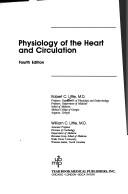
ISBN: 081515478X Year: 1989 Publisher: Chicago, Ill. Year Book Medical Publishers
Abstract | Keywords | Export | Availability | Bookmark
 Loading...
Loading...Choose an application
- Reference Manager
- EndNote
- RefWorks (Direct export to RefWorks)
Cardiovascular system --- Blood Circulation --- Cardiovascular Physiological Phenomena --- Heart --- bloedsomloop --- fysiologie --- hart --- Cardiovascular Physiological Concepts --- Cardiovascular Physiological Phenomenon --- Cardiovascular Physiological Process --- Physiology, Cardiovascular --- Cardiovascular Physiologic Processes --- Cardiovascular Physiological Processes --- Cardiovascular Physiology --- Cardiovascular Physiological Concept --- Cardiovascular Physiological Phenomenas --- Concept, Cardiovascular Physiological --- Concepts, Cardiovascular Physiological --- Phenomena, Cardiovascular Physiological --- Phenomenon, Cardiovascular Physiological --- Physiologic Processes, Cardiovascular --- Physiological Concept, Cardiovascular --- Physiological Concepts, Cardiovascular --- Physiological Phenomena, Cardiovascular --- Physiological Phenomenon, Cardiovascular --- Physiological Process, Cardiovascular --- Physiological Processes, Cardiovascular --- Process, Cardiovascular Physiological --- Processes, Cardiovascular Physiologic --- Processes, Cardiovascular Physiological --- Cardiovascular System --- Circulation, Blood --- Blood Flow --- Blood Flows --- Flow, Blood --- Pulsatile Flow --- Physiology --- physiology --- Blood physiology. Circulatory physiology
Book
ISBN: 3039212486 3039212478 Year: 2019 Publisher: MDPI - Multidisciplinary Digital Publishing Institute
Abstract | Keywords | Export | Availability | Bookmark
 Loading...
Loading...Choose an application
- Reference Manager
- EndNote
- RefWorks (Direct export to RefWorks)
The term ‘biomedical engineering’ refers to the application of the principles and problem-solving techniques of engineering to biology and medicine. Biomedical engineering is an interdisciplinary branch, as many of the problems health professionals are confronted with have traditionally been of interest to engineers because they involve processes that are fundamental to engineering practice. Biomedical engineers employ common engineering methods to comprehend, modify, or control biological systems, and to design and manufacture devices that can assist in the diagnosis and therapy of human diseases. This Special Issue of Fluids aims to be a forum for scientists and engineers from academia and industry to present and discuss recent developments in the field of biomedical engineering. It contains papers that tackle, both numerically (Computational Fluid Dynamics studies) and experimentally, biomedical engineering problems, with a diverse range of studies focusing on the fundamental understanding of fluid flows in biological systems, modelling studies on complex rheological phenomena and molecular dynamics, design and improvement of lab-on-a-chip devices, modelling of processes inside the human body as well as drug delivery applications. Contributions have focused on problems associated with subjects that include hemodynamical flows, arterial wall shear stress, targeted drug delivery, FSI/CFD and Multiphysics simulations, molecular dynamics modelling and physiology-based biokinetic models.
risk assessment --- n/a --- stability study --- inclined ?-channel --- lab-on-a-chip --- pipette Petri dish single-cell trapping (PP-SCT) --- Abdominal Aortic Aneurysm --- drug delivery --- human biomonitoring --- abdominal aortic aneurysm --- shikonin --- hyaluronic --- Computational Fluid Dynamics (CFD) --- exposure reconstruction --- doxorubicin --- biokinetics --- blood flow --- gelation --- hyperbranched polyester --- single cell analysis --- capillary --- liposomes --- meniscus --- small vessel --- spreading --- alkannin --- hydrogel --- single-cell trapping --- drug delivery system --- microfluidics --- viscoelastic --- CFD --- FFMR --- computational fluid dynamics simulations --- biochemical processes --- hematocrit --- pressure drop --- passive trapping --- dipalmitoylphosphatidylglycerol (DPPG) --- arterial wall shear stress --- cell capture --- free-flowing film --- falling film microreactor --- non-Newtonian --- pulsatile flow --- tilt trapping --- haematocrit --- ?-PIV --- viscous --- hydrodynamics --- gravitational --- fluid–structure interaction --- blood --- physiology-based biokinetics --- simulations --- droplet spreading --- human bio-monitoring --- shear thinning --- Fluid-Structure Interaction (FSI) --- cancer --- bisphenol A --- Casson fluid --- fluid-structure interaction
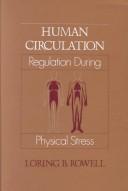
ISBN: 0195040759 Year: 1986 Publisher: New York (N.Y.) : Oxford university press,
Abstract | Keywords | Export | Availability | Bookmark
 Loading...
Loading...Choose an application
- Reference Manager
- EndNote
- RefWorks (Direct export to RefWorks)
Blood physiology. Circulatory physiology --- Blood Circulation. --- Stress, Physiological. --- 612:796 --- Blood --- -Hemodynamics --- Regional blood flow --- Stress (Physiology) --- Physiological stress --- Tension (Physiology) --- Adaptation (Biology) --- Circulation, Regional --- Regional circulation --- Blood flow --- Hemodynamics --- Cardiac output --- Hydrodynamics --- Body fluids --- Fear of blood --- Biological Stress --- Metabolic Stress Response --- Physiological Stress Reaction --- Physiological Stress Reactivity --- Physiological Stress Response --- Metabolic Stress --- Physiological Stress --- Biological Stresses --- Metabolic Stress Responses --- Metabolic Stresses --- Physiological Stress Reactions --- Physiological Stress Responses --- Physiological Stresses --- Response, Metabolic Stress --- Responses, Metabolic Stress --- Stress Reaction, Physiological --- Stress Reactions, Physiological --- Stress Response, Metabolic --- Stress Response, Physiological --- Stress Responses, Metabolic --- Stress, Biological --- Stress, Metabolic --- Stresses, Biological --- Stresses, Metabolic --- Stresses, Physiological --- Circulation, Blood --- Cardiovascular System --- Pulsatile Flow --- Fysiologie van de sport --- Circulation --- -Regulation --- Hemodynamics. --- Regional blood flow. --- Adaptation, Physiological. --- Regional Blood Flow. --- Stress. --- Regulation. --- physiology. --- 612:796 Fysiologie van de sport --- Stress (Physiology). --- Blood Circulation --- Stress, Physiological --- Circulation&delete& --- Regulation --- Abiotic Stress --- Abiotic Stress Reaction --- Abiotic Stress Response --- Abiotic Stress Reactions --- Abiotic Stress Responses --- Abiotic Stresses --- Reaction, Abiotic Stress --- Reactions, Abiotic Stress --- Response, Abiotic Stress --- Stress, Abiotic --- Stresses, Abiotic --- Biotic Stress --- Biotic Stresses --- Stress, Biotic --- Blood Flow --- Blood Flows --- Flow, Blood --- Regulation of blood circulation --- Biological control systems
Book
Year: 2021 Publisher: Basel, Switzerland MDPI - Multidisciplinary Digital Publishing Institute
Abstract | Keywords | Export | Availability | Bookmark
 Loading...
Loading...Choose an application
- Reference Manager
- EndNote
- RefWorks (Direct export to RefWorks)
As faster and more efficient numerical algorithms become available, the understanding of the physics and the mathematical foundation behind these new methods will play an increasingly important role. This Special Issue provides a platform for researchers from both academia and industry to present their novel computational methods that have engineering and physics applications.
radial basis functions --- finite difference methods --- traveling waves --- non-uniform grids --- chaotic oscillator --- one-step method --- multi-step method --- computer arithmetic --- FPGA --- high strain rate impact --- modeling and simulation --- smoothed particle hydrodynamics --- finite element analysis --- hybrid nanofluid --- heat transfer --- non-isothermal --- shrinking surface --- MHD --- radiation --- multilayer perceptrons --- quaternion neural networks --- metaheuristic optimization --- genetic algorithms --- micropolar fluid --- constricted channel --- MHD pulsatile flow --- strouhal number --- flow pulsation parameter --- multiple integral finite volume method --- finite difference method --- Rosenau-KdV --- conservation --- solvability --- convergence --- transmission electron microscopy (TEM) --- convolutional neural networks (CNN) --- anomaly detection --- principal component analysis (PCA) --- machine learning --- deep learning --- neural networks --- Gallium-Arsenide (GaAs) --- radiation-based flowmeter --- two-phase flow --- feature extraction --- artificial intelligence --- time domain --- Boltzmann equation --- collision integral --- convolutional neural network --- annular regime --- scale layer-independent --- petroleum pipeline --- volume fraction --- dual energy technique --- prescribed heat flux --- similarity solutions --- dual solutions --- stability analysis --- RBF-FD --- node sampling --- lebesgue constant --- complex regions --- finite-difference methods --- data assimilation --- model order reduction --- finite elements analysis --- high dimensional data --- welding
| Listing 1 - 10 of 12 | << page >> |
Sort by
|

 Search
Search Feedback
Feedback About UniCat
About UniCat  Help
Help News
News